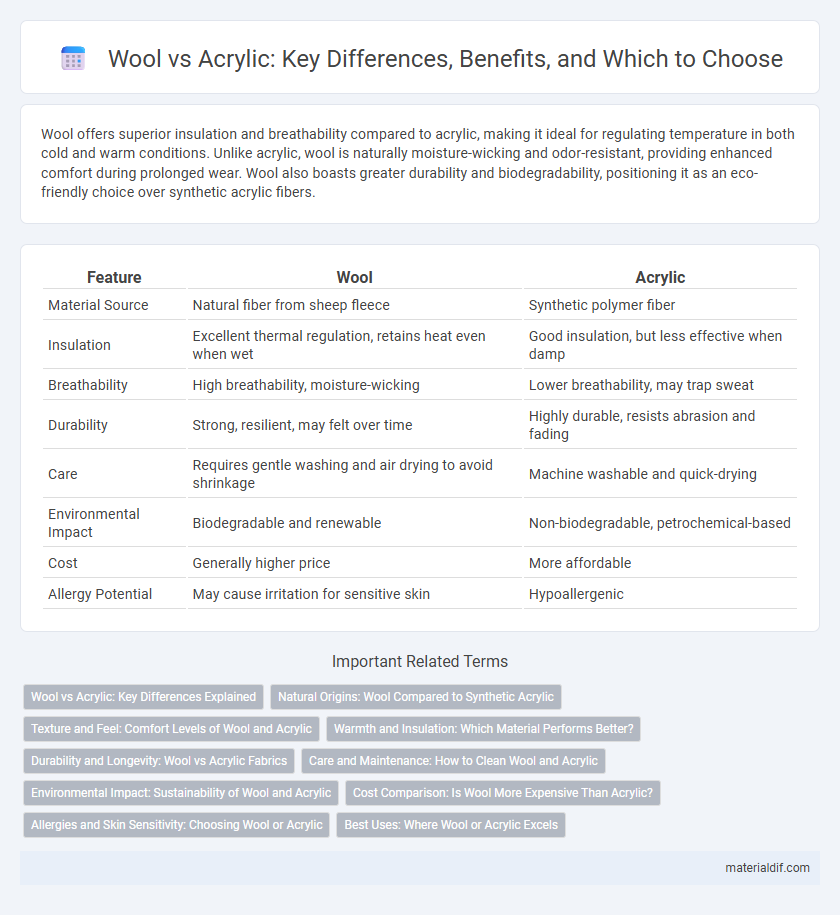Wool offers superior insulation and breathability compared to acrylic, making it ideal for regulating temperature in both cold and warm conditions. Unlike acrylic, wool is naturally moisture-wicking and odor-resistant, providing enhanced comfort during prolonged wear. Wool also boasts greater durability and biodegradability, positioning it as an eco-friendly choice over synthetic acrylic fibers.
Table of Comparison
| Feature | Wool | Acrylic |
|---|---|---|
| Material Source | Natural fiber from sheep fleece | Synthetic polymer fiber |
| Insulation | Excellent thermal regulation, retains heat even when wet | Good insulation, but less effective when damp |
| Breathability | High breathability, moisture-wicking | Lower breathability, may trap sweat |
| Durability | Strong, resilient, may felt over time | Highly durable, resists abrasion and fading |
| Care | Requires gentle washing and air drying to avoid shrinkage | Machine washable and quick-drying |
| Environmental Impact | Biodegradable and renewable | Non-biodegradable, petrochemical-based |
| Cost | Generally higher price | More affordable |
| Allergy Potential | May cause irritation for sensitive skin | Hypoallergenic |
Wool vs Acrylic: Key Differences Explained
Wool, a natural fiber derived from sheep, offers superior insulation and breathability compared to acrylic, a synthetic fiber made from polymer compounds. Unlike acrylic, wool is hypoallergenic, moisture-wicking, and biodegradable, making it an eco-friendly choice with natural temperature regulation. Acrylic excels in affordability and colorfastness but lacks the durability and comfort that wool provides in cold and damp conditions.
Natural Origins: Wool Compared to Synthetic Acrylic
Wool, derived from animal fibers such as sheep fleece, offers natural breathability and moisture-wicking properties compared to synthetic acrylic made from polymer fibers. The biodegradability of wool ensures less environmental impact, while acrylic's production relies on petrochemicals, contributing to higher carbon emissions. Wool's renewable origin supports sustainable textile practices, contrasting with the non-renewable, chemically intensive manufacturing of acrylic.
Texture and Feel: Comfort Levels of Wool and Acrylic
Wool offers a naturally soft, breathable texture that provides superior comfort by regulating body temperature and wicking moisture away from the skin. Acrylic, while often softer initially, lacks the moisture-wicking properties of wool and can feel less breathable, sometimes causing discomfort during extended wear. The tactile sensation of wool feels warmer and more luxurious, making it a preferred choice for comfort-focused garments.
Warmth and Insulation: Which Material Performs Better?
Wool outperforms acrylic in warmth and insulation due to its natural crimped fibers that trap heat and provide superior thermal regulation. Wool retains warmth even when damp, thanks to its moisture-wicking properties, unlike acrylic which tends to lose insulating ability when wet. The breathable structure of wool ensures better temperature control, making it the preferred choice for cold-weather clothing.
Durability and Longevity: Wool vs Acrylic Fabrics
Wool fibers exhibit superior durability and longevity compared to acrylic fabrics, as wool's natural crimp and elasticity allow it to retain shape and resist wear over time. Acrylic, a synthetic material, tends to pill and break down more quickly under frequent use and washing, reducing its lifespan. Wool's resilience makes it ideal for long-lasting garments and textiles that maintain their integrity through extended wear.
Care and Maintenance: How to Clean Wool and Acrylic
Wool requires gentle care, ideally hand washing with cold water and mild detergent or dry cleaning to maintain its natural fibers and prevent shrinkage; avoid wringing or twisting the material. Acrylic is more durable in maintenance, typically machine washable on a gentle cycle using warm water, and can be dried easily without special handling, although high heat should be avoided to prevent melting or deformation. Proper cleaning techniques preserve wool's insulation and softness, while acrylic benefits from its easy-care properties and resistance to moth damage.
Environmental Impact: Sustainability of Wool and Acrylic
Wool is biodegradable and renewable, sourced from sheep that can be shorn annually with minimal environmental disturbance, making it a sustainable textile choice. Acrylic, derived from fossil fuels, contributes to pollution and microplastic emissions during washing, raising concerns about long-term environmental harm. The carbon footprint of wool is balanced by its natural lifecycle and soil-regenerative grazing practices, whereas acrylic production relies on energy-intensive chemical processes with non-renewable resources.
Cost Comparison: Is Wool More Expensive Than Acrylic?
Wool generally costs more than acrylic due to its natural origin, labor-intensive harvesting, and superior insulation properties. Acrylic fabric, made from synthetic polymers, is cheaper to produce and often preferred for budget-friendly clothing and home textiles. The price difference is influenced by factors like durability, warmth, and environmental sustainability, with wool offering long-term value despite its higher initial expense.
Allergies and Skin Sensitivity: Choosing Wool or Acrylic
Wool is a natural fiber known for its breathability and moisture-wicking properties, making it generally suitable for those with sensitive skin, although some individuals may experience itchiness or allergic reactions due to lanolin. Acrylic, a synthetic fiber, is hypoallergenic and less likely to cause skin irritation, making it a preferred choice for people prone to allergies or dermatitis. When choosing between wool and acrylic, understanding personal skin sensitivity and allergy history is crucial to make the best decision for comfort and health.
Best Uses: Where Wool or Acrylic Excels
Wool excels in insulation and moisture-wicking, making it ideal for cold-weather clothing and outdoor gear due to its natural breathability and ability to retain warmth even when wet. Acrylic performs best in budget-friendly fashion items and machine-washable apparel, offering softness similar to wool but with greater resistance to moths and fading. For performance wear, wool is preferred in high-end thermal layers, while acrylic suits casual, everyday garments requiring easy care and vibrant color retention.
Wool vs Acrylic Infographic

 materialdif.com
materialdif.com